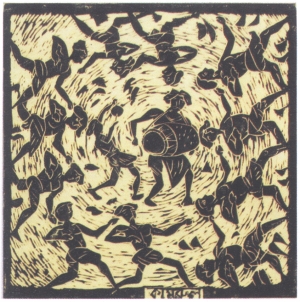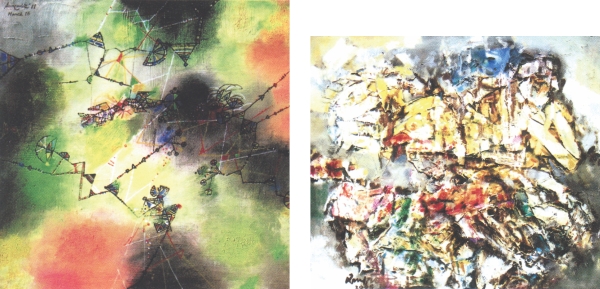| Home - Back Issues - The Team - Contact Us |
 |
| Volume 11 |Issue 16 | April 20, 2012 | |
|
|
Art Another Glorious Year Fayza Haq
Once more Saju's yearly collection of art pieces brings the best for the art buffs of the city. One of the pioneer art galleries of Dhaka, this grand exhibit in Gulshan 2, opened for the public, for a month, showcases the works of 95 of the major artists, including the great master painters. It is certainly worth braving the traffic to that part of the city. Video art and digital art, expressionism and impressionism have been included-- with the same measure of passion and innovative mind. Realism and abstraction have been given equal care and love. Experiments and innovations have been portrayed in full swing by Ramiz Ahmed Chowdhury in his grand collection. If anything makes the mind swing and reel, it's surely Quamrul Hasan's “Dholak”, an intro rather than a “piece de resistance” that comes last. One savours this as “Patua” Quamrul's masterpiece in black and pale yellow, which ushers in action and happy memories of the past and present. This goes hand in hand with SM Sultan's enlarged muscles of the farmer, who plods his way through labouring with the sickle - a reminder of the country's dependence on the countryside and nature's bounty. The black and white extravaganza of the nonpareil maestros continues with Safiuddin Ahmed's “Flood”. This brings in the inclement weather, and people's unmitigated struggle, despite the repeated floods and famines of Bengal. The etching is something that art lovers of the Subcontinent can never get enough of. The art collector has done a good job and not let down the connoisseurs. Monirul Islam of Spain is also featured with his “Musical Note”, “Broken Sun”, “Dialogue in Blue” and his “La fist-Del Prima-Vera” dance with his romantic vision of colours, lines and curves. His powder blue cascades with gold and duck yellow and emerald green. The figures are done in black mix with the images of a guitar and a dancing girl. Other electric gadgets appear natural and normal to modern existence. The artist appears contented and serene with his vicinity. The backdrop of beige is amalgamated with the collection of bric a brac and other necessities of life and living in the 21st century with a merry juggle of the past with the present. The four art pieces abound with joie de vivre, as does most of Monir's work, displayed here or overseas. Samasit Roy Chowdhury's “Essence of Nature” appears to be bursting with life and the buoyancy that we normally find in this maestro's paintings. Geometrical patterns include items taken from a passing parade of life. The painting bursts with vivacity and pulsates with green, orange and yellow offset by jet-black, which speak of the harmo nious co-existence of many elements in our Sub continental life. Gold, brown and blue are all that is needed in Syed Jehangir's “Equal strength” that bring in women at work, all stepping with apparently jocund spirit, despite the heat and dust. “Silhouettes of city life” radiates with energy, as her paintings have always done before. Flying birds and floral sprays are brought to mind, with the dance of night lights.
Biren Shome's “Painting -1”, done in rich imperial red and squiggles of egret white, sweeps of rectangular gold and jet-black. If one longs for rich hues, Biren's colours are always there, to lend harmony and contentment. Shahid Kabir's “The Slam Queen”, although exhibited earlier, at another place and time, lends serenity and beauty of the ordinary human form, going about doing every day work in repose. The midnight black trailing of waist length tresses, with a single blossom, the white sari being deftly draped around the vermilion petticoat, lends joy. This vision of the semi nude female form is seen against a gold room wall. Shahabuddin's “Bathing” is a similar interesting form in figure work. “Music” by Kanak Champa Chakma is intriguing, with few basic colours, as is always her work, at all times. It is different from other works as it does not include a portrait of the Chakma men and women dancing, or priests in saffron, but is an elongated portrait of the Chakma girl, seen in white and blue. The vision is fresh, and different from items seen before by this patron of the Hill Tracts people. It's said that that Kanak's paintings are sold before they are even hung up in the galleries. “Untitled-1” by Mahmudul Haque is an arrangement of white against egg-yolk blue usher in nature- as do most of the master painter's work. Nasim Ahmed Nadvi's entry “Rain” too deals with Nature's inimitable charm, and the call of the wild. This is done in a subtle, individualised manner—inimitable, as Nadvi always is. Rebeca Sultana's elongated female face, decked to the hilt, with jewellery and a single large flower remains charming and inviting. Firoze Mahmud, from overseas, has left the exotic world of the princes of India in the past.This is done with subtlety, care, imagination and skill of the artist's own. “Padma” by Rezaun Nabi, with its simplification and choice of colours and forms, cries out for attention too. Rafi Haque's “Untitled”, with its simplicity of black and brown rectangles, with the backdrop of green cannot be ignored. Atia Islam Anne, with her “Secret Murder,”is certainly obsessed with the ugliness and gruesome elements in man's existence in Bangladesh, and other South Asian cities. Her preoccupation with dismembered limbs is something that will eternally haunt her viewers. Young Nagarbasi Barman's yellow and white stark simplicity calls “Au revoir” to the remarkable display that will go on till May 8.
|
||||||||||||||||
Copyright
(R) thedailystar.net 2012 |
|||||||||||||||||



